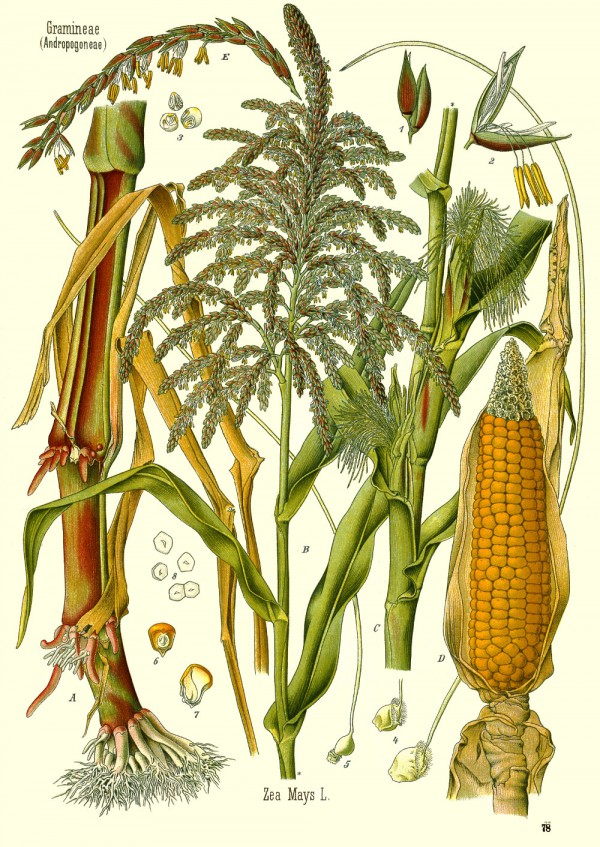Zea mays L. subsp. mays - Poaceae - (sweet) corn, Mais
Erect culms up to 4m tall, domesticated in Central America; leaves up to 90cm long, glabrous or with tubercle-based hairs, margins scabrid, midvein stout; female inflorescence a cylindrical „cob,“ with 16-30 rows of spikelets; male inflorescence a „tassel“ of many digitate racemes.
„This plant (maize, corn) was first domesticated in Central America about 7000 years ago and is now the third most important crop in the world. The many cultivars are grown for cereal or forage, and it is also an important source of oil, syrup, and alcohol.“ http://www.efloras.org/florataxon.aspx?flora_id=2&taxon_id=200026507
Raw corn contained no methyl sulfide, but in canned or heated sweet corn samples, its content was in average 8.7 ppm. Because the odor treshold is in the range of some ppb, the compound is an important flavour constituent of heated corn.
[Dimethyl sulfide and its precursor in sweet corn., Bills, D.D., Keenan, T.W., Journal of Agricultural and Food Chemistry, 16(4), 1968, 643-645]
„Dimethyl sulfide (DMS) was the most abundant aroma volatile in cooked sweet corn head-space, followed by ethanol, acetaldehyde, hydrogen sulfide (H2S), ethanethiol, methanethiol and another unidentified compound unique to processed corn. Based on sensory monitoring of GC column effluents, DMS was determined as the primary factor in cooked corn aroma along with H2S, methanethiol and, to a lesser degree, ethanethiol. Also detected in the effluents, but probably of lesser importance, were acetaldehyde, ethanol, and a “grainy” smelling compound in processed corn. When panelists were asked to score corn of widely varying characteristics for aroma, sweetness, texture and overall flavor, it was found that aroma contributed 15% to the flavor response while sweetness and texture contributed 55% and 30%, respectively.“
[Sweet corn aroma, chemical components and relative importance in the overall flavor response., Flora, L.F., Wiley, R.C., Journal of Food Science, 39(4), 1974, 770-773]
„The volatiles of some canned, frozen, and fresh sweet corn products were analyzed by capillary GLC-MS. Important aroma compounds identified include 2-acetyl-1-pyrroline and 2-acetyl-2-thiazoline. Major volatiles found in all three corn products include dimethyl sulfide, 1-hydroxy-2-propanone, 2-hydroxy-3-butanone, and 2,3-butanediol. Pyridine, pyrazine, alkylpyrazines, and 2-acetylthiazole were additional major components in the canned products but minor components in the fresh and frozen products. Comparison of calculated odor units indicated that the compounds most important to canned sweet corn aroma include dimethyl sulfide, 2-acetyl-1-pyrroline, 2-ethyl-3,6-dimethylpyrazine, acetaldehyde, 3-methylbutanal, 4-vinylguaiacol, and 2-acetylthiazole.“
[Studies on flavor volatiles of some sweet corn products., Buttery, R.G., Stern, D.J., Ling, L.C., Journal of Agricultural and Food Chemistry, 42(3), 1994, 791-795]
„Application of an aroma extract dilution analysis to freshly prepared popcorn revealed 23 odorants among which 2-acetyl-1-pyrroline (roasty, popcorn-like), (E,E)-2,4-decadienal (fatty), 2-furfurylthiol (coffee-like), and 4-vinyl-2-methoxyphenol (spicy) predominated with the highest FD factors (odor activities). Further potent flavor compounds showing roasty odors were 2-acetyltetrahydropyridine and 2-propionyl-1-pyrroline. The latter compound showed a very low odor threshold of 0.02 ng/L (air), which was in the same magnitude as that reported for the 2-acetyl-1-pyrroline homologue. Sensory analysis of homologues 2-butanoyl- and 2-hexanoyl-1-pyrroline revealed that a longer alkyl side chain canceled the roasty flavor note and increased the odor thresholds by a factor of 10⁵.“
[Schieberle, Peter. „Primary odorants in popcorn.“ Journal of agricultural and food chemistry 39.6 (1991): 1141-1144]
Gas chromatography/mass spectrometry/olfactometry (GC/MS/O) analysis of refined and whole grain extruded maize puffs reported 13 aroma compounds with a flavor dilution (FD) value ≥16 (with odor descriptor): Hexanal (green/oxidized), 2-methylpyrazine (roasted), 2,3-dimethylpyrazine (roasted), 2,5-dimethylpyrazine (roasted), 2-methyl-2-thiazoline (roasted/toasted), 2-pentylfuran (earthy/oxidized), 2-ethyl-3,5-dimethylpyrazine (roasted), 3-hydroxy-2-methyl-4H-pyran-4-one (maltol; caramel/toasted), 2-methoxyphenol (guaiacol; smokey), 2-acetyl-2-thiazoline (popcorn/corn chip), (E,E)-2,4-decadienal (oxidized), 2-methoxy-4-vinylphenol (4-vinyl guaiacol; clove), 4-hydroxy-3-methoxybenzaldehyde (vanillin; vanilla-like).
[Smith, Kenneth, and Devin G. Peterson. „Identification of Aroma Differences in Refined and Whole Grain Extruded Maize Puffs.“ Molecules 25.9 (2020): 2261]
https://www.mdpi.com/1420-3049/25/9/2261/pdf

Köhler,F.E., Medizinal Pflanzen, vol.3 t.78 (1890)
http://plantgenera.org/species.php?id_species=1081381
Zea mays
© Rolf Marschner (2005),
www.botanische-spaziergaenge.at



